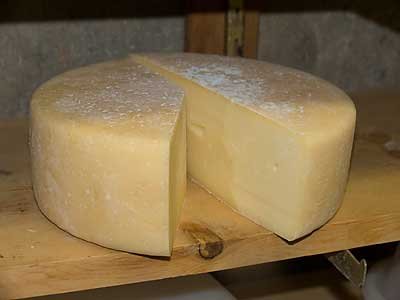
Asiago Cheese Recipe
-
Yield
6 Pounds
-
Aging Time
~2 Months
-
Skill Level
Intermediate
-
Author
Jim Wallace

Asiago Cheese Recipe Info
Asiago’s Mountain Home
Two Styles of Asiago Cheese
Flavor and Pairing Notes
Asiago’s Heritage and Legacy
Ingredients
Total price for selected items: Total price:
Instructions
Before you Start
The batch size is 6 gallons but can be increased or decreased by altering the ingredients proportionately.
The milk for this recipe can be from either a pasteurized whole milk or a rich fresh farm milk. I have used an unpasteurized Jersey/ Normand mix with the fat% running close to 5%. If using pasteurized milk adding a little more cream could be an option for a richer cheese. This cheese will also use 2 cultures:
- A Thermophilic culture such as our C201 or TA061 will acidify the cheese by converting lactose to lactic acid.
- The second culture will be a Helveticus culture (LH100) which is characterized by it's ability to convert only part of the milk sugar and leave a sweet note in the final cheese. This is also a component in most of the Alpine style Swiss cheeses.There are many options for making Cottage Cheese. For this recipe I have decided to use the shorter set time to make it a little more practical for the home cheese maker. Enjoy!
-

Heat & Acidify Milk
Begin by heating the milk to 95-97¡F (warmer during the colder months and with higher fat%).
Once the milk is at the target temperature the following two cultures can be added:
- 3/4 to 1 pack of C201 Thermophilic Culture or 1/8 tsp of TA061 Culture
- 1/16 tsp LH100 Culture
This may seem like a small amount of culture because Asiago depends on a very slow acid development and much of this will take place on the second day while the cheese rests in the mold before salting.
The milk should then be allowed to ripen for 30 minutes before adding rennet.
-

Coagulate with Rennet
Add 5 ml of a single strength calf rennet once the milk has ripened. Enough rennet is added to form a good curd in about 25 minutes.
Stir the rennet into the milk in an up and down manner so that the milk quickly comes to rest.
Once the curd begins to set you will notice a thickening as the surface tension increases. It is still too soft to cut at this point.
When the full coagulation develops the curd will split cleanly.
-

Cut Curds & Release Whey
Once the curd has firmed it can be cut into about 3/8-1/2 inch pieces. The curds should then be slowly stirred for about 15-20 minutes until they become firmer. The temperature should be adjusted to the original culture temp.
-


Cook Curds
Once the curds are firm, the heating of the curd begins by heating to 106¡F in 20 minutes. It is then held at this temp while stirring slowly for 15 min.
During the next 10 minutes, the heat is increased to 118F (during cool weather or with high fat % milk it may need to go as high as 123¡F).
At this point the curd should be dry enough but will need to produce more acid before draining. This can be accomplished by allowing the curd to settle to the bottom for another 20 minutes. They should be stirred lightly to keep from matting every 3-5 minutes.
-




Drain Curds
Asiago needs to be drained well while keeping the curds separate. This will allow for the somewhat open texture of this cheese.
The curds need to be cooked to their final moisture then a cloth and draining pan are sanitized in hot water in preparation for the curd transfer and whey drainage.
The whey is then removed to the curd level and the curd is transferred to the draining pan.
-




Mold Curds
The curds can now be transferred into a cloth lined cheese mold.
I use a mold diameter of about 7.5 inches for this cheese. The cloth should be folded over and a follower placed on top.
-



Press Curds
12 lbs of weight can be applied to the cheese mold for 30 minutes, then removed. After 30 minutes, flip the curds in the cloth and press with 25 lbs of weight for the 2 hours. After 2 hours, turn, re-wrapped and press with 25 lbs for another 2 hours.
At this point the cheese should be well consolidated. The weight can be removed and the cheese replaced in the mold.
The mold should be kept warm overnight at 75-85¡F while the bacteria continues to work producing more acid in the cheese. No salt should be added on the second day and again it is held overnight.
-


Salt & Age
On the third morning the cheese will be brined in a saturated brine at a rate of 3 hrs per lb. of cheese.
The cheese is now ready to be aged for 30-40 days.
The aging temperature is 54-58¡F and humidity of 85-87% should be maintained. Any surface mold should be wiped away with a saturated brine solution.
Cheese Making Supplies
Related Products
You May Also Like




































